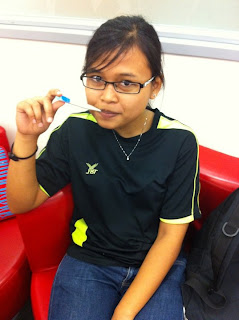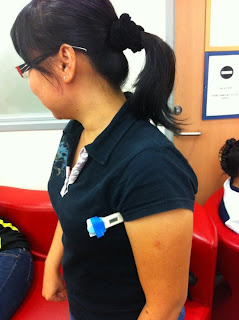As a group, overall, we enjoyed the process of completing the blog for this module as compared to other modules. It introduces a new presentation style by submitting our projects in a form of a blog as it exposes us to IT and how to go about it. Collection of data was fun although there were some of our subjects who refused photo-takings and we respected their choice. Albeit the initial complains of how complicated SPSS was, we came to realize that SPSS was a useful tool in interpreting and analyzing findings. Although this project was a challenge for us, we are proud to say that we managed to overcome the challenge by our awesome teamwork and hence, this blog is the product of our hard work.
AMALINA
Finally. We're capable to finish up our project within the time frame that we have planned. Despite of the hiccups along the process of the different projects that we are also required to meet up with the deadlines, as a teamwork we managed to pull through every each them. After doing this project, it does change my perception towards statistics, i believe this module will be a helpful tool to me in future and glad that it has been introduced to us earlier.
HAN HUI LIN
At the starting, i thought that this module was not in any way related to our course. But after understanding it and hands on to create this blog, I eventually understand the importance of introducing this module to us now. SPSS is useful and easy to use too. And in future, it will be useful to me if I need to collate any data.
LI TIAN TIAN
This is the first time which i have done a blog of my ICA project. I have experience a very meaningful and interesting procedure throughout. I am sure that SPSS will be useful in my future to help me analyze and interpret data.Our group have been work together to come out this successful blog, last but not least, hope that you will enjoy our hard work.
LINA SIM SI BEI
Finally this is our end product of our project. I am very satisfied with our end product, as we put in a lot of hard work into it. This project allowed me to learn the skill of creating a blog, which is my very first time. I find this project interesting and fun as it exposed me to a "new" software which I never heard of. SPSS is capable of creating graph, analyze and interpret data. It will definitely be a useful tool to me in future.
RACHEL LIM RUI XIAN
It has been an enjoyable experience creating this blog. In the beginning, we were faced with difficulties.Despite the setbacks, we were able to overcome it with the help of our group work power! Through this project, i have learn to work as a group and also learn how to use the SPSS programme to collect data. I am very sure that this programme would come in handy next time. At the end of the day, i have enjoyed and have gained more knowledge through this period of time.I am very grateful to have this module.Thank you.Hope you enjoy our end product.
RINA NG
Having completed this blog gave me a sense of accomplishment because I never thought that we would pull through this "impossible" project, but we motivated each other along the way. As we went along, we realized that this project requires a lot of teamwork and consistency to produce a good work, and I'm proud to say that this blog contains the best efforts contributed by each and every one of us.


































